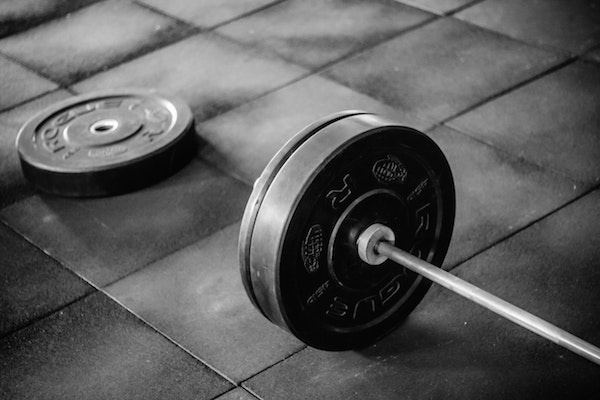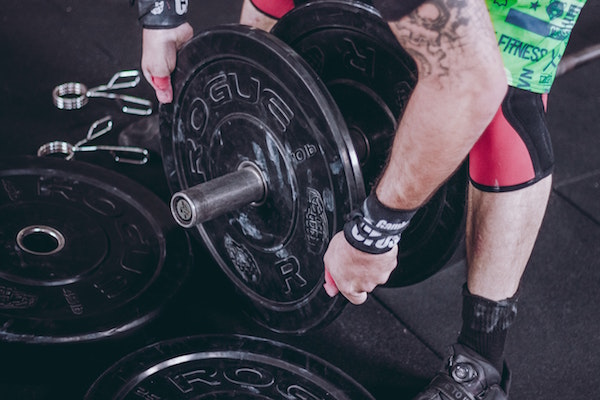If you’re relatively new to lifting weights, you might sometimes hear people talking about their lifts in terms of “plates.”
For example, “I just hit a two plate bench!”
When I was first starting out, I had no idea what that meant.
What is a plate and how much does it weigh? What does it mean if someone “benches a plate”?

When people in the US (or other countries that utilize the Imperial system of measure) refer to a plate or one plate in weightlifting, they’re usually talking about one 45-pound Olympic weight plate.
I’d say the most common usage is talking about plates in terms of the bench press. So a one plate bench would be one 45-pound plate per side of the bar, plus the weight of the bar (45 pounds), for a total of 135 pounds.
Two plates most often means two 45-pound plates per side of the bar, which including the weight of the Olympic barbell gives you a total weight of 225 pounds.
Three plates, again, usually means three plates per side. Plus 45-pounds (which is how heavy the barbell weighs) gives you a total of 315 pounds.
Four plates usually means 405, and five plates usually means 495-pounds.
The exception here would be movements that don’t use a barbell. For example, a two plate weighted pull up would only be referring to the two 45 pound plates and nothing else, for a total of 90 pounds of resistance.
Why are weight plates 45 pounds and not 50?
This is a really good and common question, and it makes sense.
Wouldn’t 50 be a much rounder number to use? It’d certainly make “gym-math” a heck of a lot easier.
The answer lies in the metric system.
Weight plates were originally designed around kilograms instead of pounds.
So the “plate” we know today is really a 20kg plate in disguise — now that’s a nice round number. That’s roughly 45 pounds in Imperial units.
Types of weight plates you’ll find at the gym
When someone’s talking about how much they lift in terms of plates, they’re almost always referring to how many 45-pound plates they use.
But there are lots of other kinds of weights at the gym that you can use to load up the bar.
Most good gyms worth their salt will have a great selection of poundages you can use, like:
- 45lbs
- 35lbs
- 25lbs
- 10lbs
- 5lbs
- 2.5lbs
The exception might be 35-pound plates. Some gyms have them and some don’t.
It’s pretty easy to get by without them if your gym doesn’t carry them, though. They’re just a 25 and a 10 put together!
But it is a lot more convenient when you can just grab a 35.
Most gyms should have 2.5-pound plates, too, though I find they’re sometimes in short supply. These are super useful because adding or removing 5 pounds (one 2.5 per side) from a lift is really helpful.
In progressive overload, you’ll often be striving to add 5 pounds at a time to your big lifts like the bench press, overhead press, or even squats and deadlifts.
(Also read: The 6 different types of free weights)
What are fractional plates for microloading?
A very large majority of gyms won’t have these, but you can buy your own fractional plates and bring them with you to the gym.
Fractional plates are plates that weigh less than 2.5 pounds. The most common size for fractional plates is 1.25 pounds each, but you can even get them as small as half a pound each!
Here’s a really great and versatile fractional plate kit on Amazon you can check out.
If that seems ridiculous, don’t laugh! Microplates are actually really useful strength training tools, and they can be helpful for two kinds of people:
Microloading for late-stage beginners
Like I wrote above, most lifting programs call for you to push to add 5 pounds at a time to your key lifts once you hit a certain rep threshold.
Let’s take the bench press for example.
Let’s say you can bench one plate (135 pounds) for 6 reps, and now your program says it’s time to try 140 pounds.
It may only be a few pounds, but percentage-wise, that is a pretty big jump. (Around 3-4%)
Adding 5 pounds to a two-plate bench (225 pounds) is a much smaller increment.
Some experts write that a strength increase of more than 2.5% or so at a time is just too difficult for most people who have milked their initial newbie gains.
Using fractional plates to add 1, 2, or 2.5 pounds to the bar instead of 5 can be a great tool to break a plateau.
Microloading for advanced lifters
On the other end of the spectrum, you have people who’ve been lifting for a very long time and have developed a lot of strength.
These people are at or very close to the limit of how much muscle they can add and how much weight they can lift.
Adding 5 pounds to a lift just like that is a very tall task for elite-level lifters.
A smaller increment could be a helpful training tool when you’re deep into your journey and are having trouble making progress.
Are weight plates really accurate?

In most cases, the weight plates you find at the gym are not perfectly calibrated.
Meaning, a 45-pound plate at your local LA Fitness might be 43 pounds, 45, or even 47. Or it may just be off by a few ounces.
This shouldn’t be a massive problem for most recreational lifters. If you stick with the same gym and the same equipment for a while, I’m not sure it really matters all that much.
(Though it could be bad if your gym uses really cheap, super poorly calibrated plates. Lifting an unbalanced bar can be dangerous.)
You can always grab the plates you want to use and drag them over to the scale, if your gym has one. If the plates are off, it’s probably a good idea to match them up so at least the balance is right (for example, pairing two 46ish pound plates together instead of a 43 and a 47).
For competitive lifters, you’re better off getting your hands on some really nice, highly-calibrated plates (something from a trusted brand like Rogue).
How much is 6 45-pound plates on each side?
It’s a lot!
You don’t hear many people talking about 6 plate lifts because, well, almost no one can do them.
A 6 plate lift is 585 pounds.
That’s an impressive number no matter how you slice it, and chances are the only lifts you’ll have a prayer of hitting for 6 plates are the deadlift and maybe the squat.
Though a 6 plate squat would be an elite-level lift for most people.
Wrapping Up
Let’s recap.
A plate at the gym for weightlifting weighs 45 pounds.
When people refer to a one, two, three, four, five, or six plate lift, they’re most often talking about that many plates per side of the bar, plus the 45-pound bar itself.
A one-plate lift, then, is 135 pounds. Two plates is 225 pounds. Three plates is 315. Four plates is 405. Five plates is 495. Six plates is 585lbs!
However, there are plenty of plates you can use at the gym that don’t weigh 45 pounds. That’s just the standard measure when it comes to charting and discussing your strength levels.
Also, it’s crucial to remember that 6 plates on a machine, like the leg press, for example, does not include the weight of a 45-pound barbell. So 6-plates per side on the leg press would be 540lbs while 6 plates total would be 270.
The more you lift, the better your mental math will get, don’t worry!
Hope this helps, folks!
(You can also check out my complete guide to more gym slang.)